|
|
 |
|
|
 |
The Following Entries are Alphabetical
Ageing Ageing is controlled by the ageing chemical that decays throughout a creatures life. At certain levels Chemical Receptor trigger ageing. There are seven life stages: |

| Picture | Stage Number | Stage Name | Description |
| 1 to 3 | - | Egg growth | Unborn |
| 4 & 5 | - | Hatching | Hatching |
| 6 | 0 | Baby | Growing |
| 7 | 1 | Child | |
| 8 | 2 | Adolescent | Mature |
| 3 | Youth | ||
| 4 | Adult | ||
| 9 | 5 | Senior | Elderly |
| 6 | Senile | ||
| 10 | - | Death | Death |
Most genes are active at birth, babies crawl on all fours and are eager to learn and eat. They grow, usually before they are an hour old, into children. Children are faster than babies as they can walk upright, they are playful and not yet fertile. 2, 3, and 4 are the mature phase and all look identical, in this phase most breeding takes place. The adolescent stage marks the beginning of puberty and eventual fertility due to certain genes being activated. Senior & senile creatures travel more, are less fertile and their fur takes on a grey tinge. PMN, Forest and Ron norns shrink when they get old. They tend to die after eight hours or so of life, unless they lack death genes or are immortal. |
| Bibble This is the instinctive language of norns before they are taught the user's language.
See the Linguistics page for details |
Behaviour Creatures have a complicated array of behaviours, they are *not* programmed into them, they are genuinely alive in that they can choose what they do in their digital world. For pictures and more in-depth detail go here. |
Biochemistry The biological chemistry of your creatures, what chemicals are in them, and how do they interact. Your creature's genetics code for enzymes which perform all chemical reactions required to keep it alive. For more in-depth detail go here.
|
Breeding Creatures do not mate in a conventional way, males transfer sperm in an extended kiss ending with a "pop" sound, known as the "kisspop". After a short pregnancy the impregnated female will lay a small egg that swells by osmosis then hatches into a fully independent baby. For a detailed description of breeding see this page, for information on female hormone cycles go here. |
Chemistry and Chemicals All creatures have a biochemical system, the chemical reactions are described by genes of the same name, receptors and emitters of the brain complete the system, so the brain can be influenced, and influence the hormones and other chemicals. See Biochemistry. |
Coughing Caused by the presence of Histamine B. See Illness |
| Crash and Crash Death This is when you lose creatures upon the computer or the game crashing. There are four ways it can happen:
|
| dDNA Stands for digital Deoxyribonucleic Acid. These files contain all the inheritable features of each creature, and are used in gene expression and reproduction.
|
Death Death is a natural part of your creature's life. There are two death receptors, one makes the creature die when there is no glycogen - a substance derived from food and used up by living. The other makes it die of old age, when the chemical "ageing" has all decayed away.
The second death receptor is a new
one introduced with the Life Kit norns to curb There are two types of creatures that do not die, the Undead and the Immortal. This is because undead creatures have no death genes, immortals have mutated ones. |
| Cause of Death | Reason | Receptor |
| Starvation | Low starch intake, with glycogen used up by regular living. |
Glycogen |
| Disease | High levels of antigens
that use up glucose as antibodies are produced. |
|
| Glycotoxin Poisoning | Glycogen is consumed by this poison. | |
| Geddonase Poisoning | Glycogen and glucose are both consumed by the toxin. |
|
| Mutation | Various reasons,
resulting in reduction of glycogen or ageing to zero. |
Glycogen / Ageing |
| Old Age | Low levels of the ageing chemical. | Ageing |
| Import Shock / SIDS | Unknown, possibly related to sleep chemicals | ? |
Egg Creatures typically lay eggs after a short pregnancy. They are porous, and absorb water through a process called osmosis, and swell up. When they are mature, they hatch. Creature eggs are sensitive to touch, and if moved when fully grown, will no longer hatch naturally. To hatch a disturbed egg, simply put it into the hatchery or similar device. There are six patterns that eggs can have:
Grendel eggs drop fully grown from the Grendel Mother after being laid, and hatch immediately upon impact with the ground.
|
Food Phobia Usually caused by poor training. If a creature does not eat when asked, you might be tempted to smack them, but be careful, they may associate such smacks with holding, approaching or looking at the food and so become fearful of all foodstuffs. Try to curb your frustration by being careful with teaching eating, and start training good eating habits as early as possible. You can also try getting them to eat a plant, but check if it is nutritious first. |
Glucose-Glycogen Cycle A cycle used to process, use and store glucose a product attained from digested food, it is the crux of a creature's biochemistry.
For more detailed information go here. |
Generation Every creature is born into the generation below that of it's parents, with generations increasing in number as time goes on.
|
| Generation | Members | Details | |
| -1 | Eve_ Gren |
Adam | Unknown genomes, perhaps just convenient label used by Cyberlife for parents of the mum and dad genomes. |
| 0 | mum1 mum2 mum3 mum4 mum5 mum6 gren |
dad1 dad2 dad3 dad4 dad5 dad6 Toby |
Represented
by the .gen files in the genetics folder or the egg disk. This generation also includes the grendel mother genome gren.gen Toby was used as the father of the Life Kit norns. |
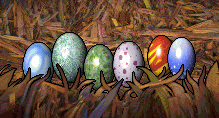 | |||
| 1 | All hatchery Norns | Each one is
created by a different combination of MUM and a DAD genomes. They emerge from eggs held in the hatchery. |
|
| 2+ | Natural Norns | Their parents are two creature parents living out in the world. | |
|
A newborn creature is always exactly one generation number higher than it's highest generation parent. For example a child of a creature in generation 57 and one in generation 60 will be a member of generation 61. An imported creature should be added to the same generation as the lowest generation it breeds with. For example a new creature breeds with generation 8 then later generation 6. It would be included in generation 6. |
Genetic Diseases There are many conditions caused by mutations that lead to diseases. Here is a short list of the more common ones, many of which are discussed in more detail on the mutants page, and there are downloads of norns with the mutation. |
||
| Anti-sociality | Similar to the food phobia gene is a gene that causes pain in crowded norns - causing them to flinch when in crowds. It can in theory make norns anti-social but does not impeach easily on norn's gregarious nature. | |
| COTM | Stands for Children Of The Mind, these norns are incapable of moving and usually constantly stare at themselves. This condition is caused by mutated lobes. | |
| Deafness / Blindness | There are rumours of norns incapable of either hearing or seeing. It is possible that this could occur, but they are likely to be confused with COTM. | |
| Food Phobia | This may not always be due to mutation, but more often by bad upbringing. Some of my norns had a mutation that caused pain in norns who ate - resulting in norns who feared food. | |
| Mercury |
Norns with this condition were named in tradition of Saturn norns. These norns are always hot, they usually have faulty emitter genes, but may instead have faulty reactions. This condition is best dealt with by using the fan. | |
| Paralysis | Not to be confused with COTM norns, although they cannot walk, they can still see and hear. | |
| Saturn | These norns are continually cold, having a faulty cold emitter gene. Norns with this condition often fall to the floor and shiver. The use of the blanket cob is recommended, as is keeping the norn in the house where it is warm. | |
| Undead | See Undead, or the page of the Undead norns | |
| Genetic Modification The use of a program to edit the .gen files containing the digital DNA of creatures. Sometimes this is to fix problematic mutations, other times for adding useful or novel genes.
See the GM Norns page for many examples to download |
Hatchery,
Natural, Test-tube & Imported Creatures: |
Histamines See Illness |
Illness The two Histamines, A and B cause respectively sneezing and coughing. Histamines are produced by bacteria or eating weeds. The best way to cope with ill creatures is to firstly isolate them from healthy creatures and each other as they get distracted from recovering and pass on illnesses. Then concentrate on feeding them, avoid feeding them junk foods such as honey, carrots are the healthiest food native to Albia. It could necessary to make sure your creature is well rested and not feverish. Remember you can use cough medicine from the Science Kit to ease your creature's sore throat. In serious cases use the Energy injection from the Science Kit to get your creature from death's door. If the creature is off its food, and suffering greatly, you may want to consider euthanasia. |
| Antigens | Chemicals | Name | Description |
| 0, 1 & 2 | 248, 249 & 250 | Influenza | Burn four times as much Glucose as Antigens 5-7, and react the slowest. These are the moderate diseases. |
| 3 & 4 | 251 & 252 | Pneumonia | Burn four times as much Glucose as Antigens 5-7, but react just as quickly. These are the worst diseases. |
| 5, 6 & 7 | 253, 254 & 255 | Common Cold | Burn less Glucose as other infections, and react the fastest. These are the mildest diseases. |
| Immortal They are creatures that never die, usually due to a mutation in the Glucose-Glycogen cycle. Occasionally they have been created via genetic modification. See Life force or the page of the Immortal norns Also see Mortality |
| Import Shock See Sudden Import Shock Syndrome |
| Import Coma | |
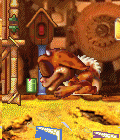 |
Occasionally if you
export sleeping creatures, or just as they fall asleep, they will be in a state of coma
when you import them. Creatures in a coma seem to be asleep but don't snore. The easiest way I've found to revive some of them was slapping, or the use of "Full Power" in BORG. Often no amount of injections help - including wake up pill. Apparently the Holo Doc is able to wake them up too. |
A variation of this is import paralysis/blindness where the creature cant open it's eyes or walk. |
|
| Lek This is the term used to describe the rutting dance performed by sexually aroused creatures. |
| Life Stage See Ageing |
| Life force Life force is measured in % of glycogen present in the blood of the subject, out of a maximum of 255 units. 77% is the ideal life-force level for a healthy creature. Babies are usually born at 46%. Consistently over 90% life force, linked with little or no need to eat is considered an immortal norn.
When a creature's life force drops to 0% they are
considered dead. Despite this there exist undead norns can still express all behaviour of regular norns,
such as walking talking etc. No undead norn has been known to successfully breed, this is
due to scripting, which could theoretically be altered. |
| Moniker This is the four letter label for each creature's genome file. It is created at conception, held in the mother's BABY tag, then applied to the egg, finally to the newborn creature. It can be revealed by looking in the Science Kit. It can be examined with Slink's dDNA Analyser. |
| Mortality There are a few descriptors for the main vital groups. Typically healthy mortal creatures hover around 77%. Immortal creatures usually stay over 96%. Undead creatures can reach 0% without actually dying. |
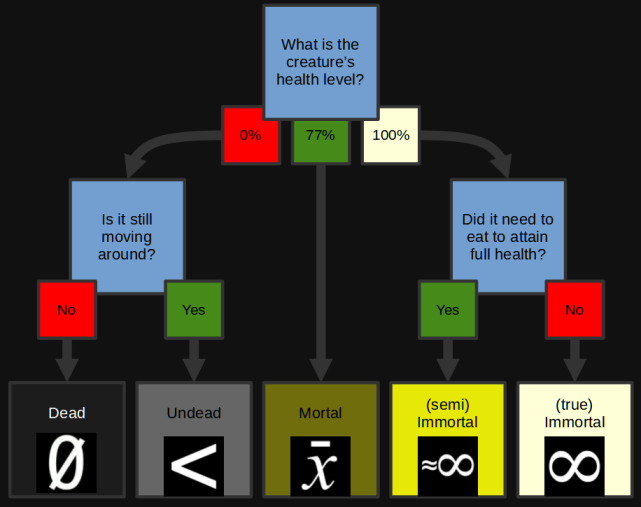
See Immortal |
| Mutation This occurs in every new creature when it's digital genome is created. They can be duplications, deletions or changes to the data. Most are benign, some are useful, others are deleterious. See Genetic Disease |
SIDS |
|
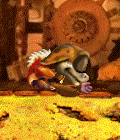 |
It can be a good idea to
make a copy before you import norns. They could die of Sudden Import Death Syndrome
(SIDS), or the program might just crash before the game next saves, see Crash Death for
more details. The true cause of SIDS is still unknown, though my studies imply that intense exhaustion before exporting could be one factor. |
SIDS can also stand for Sudden Infant Death Syndrome or Stillbirth. See that entry for more details |
|
Shivering Coldness causes shivering, looking disturbingly as if the creature is having a fit. No serious harm comes from chills, just an unpleasant feeling for the creature, and punishment. Simply take the creature to a warmer place, or take a mobile heater to them such as the baby blanket cob. |
| Sleep Norns do not usually sleep that often or for long. Do not worry if your norns seem hyperactive, this is perfectly nornal. During sleep, instinct genes are processed, in a similar way to human dreaming.
For a more detailed description of sleep cycles and the chemicals that are involved go to this page. |
Sleep-Active Creatures |
||
 |
Occasionally
creatures toss and turn around a lot in their sleep, stand up. Some breeders have reported
sleepwalkers! I am uncertain as to whether this is a mutation (but this is doubtful), a glitch in the software, a response to stress or perhaps even dreams... |
|
| To the left is a picture
of a norn sleeping stood up - perhaps she was too exhausted to even lie down? To the right is a picture of two norns following my hand whilst asleep. I called to them and they began to watch me, yet kept their eyes closed, snored and didn't move their feet. |
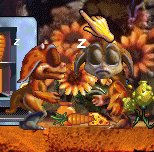 |
|
Sneezing Caused by the presence of Histamine A. See Illness |
| STDs Or Sexually Transmitted Disease. Do not exist in norns per se, but colds and other illnesses may be passed on during mating, although they are usually transmitted by coughing and sneezing. |
| Sudden Import Shock Syndrome This is when a norn died immediately following creature import, and is a good reason why you should backup your .exp files. |
Stillbirth Also known as either Sudden Infant Death Syndrome, in which norns die upon, immediately after, or even before birth. These are known to be due to mutations as even clones of them die.
Some are due to mutated "initial chemical concentration" genes, others from lethal alterations to the glucose-glycogen cycle. One I saw was due to the norn digesting the ageing chemical. |
| Test tube Creature A creature that has been hex edited; or altered by a program such as Creatures Editor then introduced into Albia is known as a test tube creature. |
| Wallbonk Wallbonking is a behaviour that many creatures display, whereby they keep walking once they hit a wall. The Stop Walking Into Walls instinct helps prevent this, as can training. |
| Undead Norns that move around and have nornal behaviour, despite being technically dead with a life force of 0%. Most can raise their health and become alive again. Some are mutants, others are GM.
See Life force or the page of the Undead norns Also see Mortality |